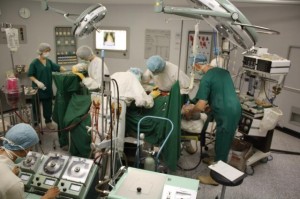 When I read JAMA, I’m often thankful I haven’t needed to be in a hospital. The March 2 issue included a commentary on why “academic health science centers” (teaching hospitals, often associated with prestigious medical schools) lack incentives to provide quality care.
When I read JAMA, I’m often thankful I haven’t needed to be in a hospital. The March 2 issue included a commentary on why “academic health science centers” (teaching hospitals, often associated with prestigious medical schools) lack incentives to provide quality care.
In the same issue was a thoughtful piece on how hospitals need to coordinate the many things they do and how the profit-driven nature of health care makes this difficult. (emphasis added in the following quotations)
On the lack of integration:
[T]rue integration of disparate data streams and clinical workflows into a single smart system, although technically possible, does not exist. Accordingly, clinicians are presented with ever-increasing amounts of raw data, often in chaotic environments, with the expectation of filtering data, prioritizing risks, and making informed treatment decisions. Consequently, safety has not improved. Ironically, the overall signal-to-noise ratio in complex health care settings may be worsening despite advances in technology and computing power.
On the profit motives that prevent integration:
The broader fragmentation of medicine extends to hospital units and even to individual patient rooms. Industry vendors depend on and promote this fragmentation with each vendor working alone trying to maximize market share. Although single-solution equipment providers exist, they still reside within isolated domains … and do not integrate with other technologies. Hospitals have largely stood on the sidelines in shaping the landscape of technology, equipment, and infrastructure in health care. They are perceived as the battleground in which vendors claim victories and admit defeats, but not as a driving force behind integration to which the market responds.
Who can make the loudest, most annoying noise?
And this was downright frightening:
The lack of an integrated system results in diagnostic errors, failures to identify deteriorating patients, communication errors, and inefficient work, all of which contribute to worker stress and burnout. For example, despite the increasing understanding that clinicians routinely ignore alarms due to noise fatigue and their perceived nuisance, more vendors of monitoring equipment have responded by making their alarms louder or more irksome, hoping to out-compete related equipment by ensuring their alarm gets attention. Yet equipment alarms are not equally important and there is currently no system that prioritizes disparate alarms. Additionally, there is no incentive for a given vendor to work with its peers on this problem. The result is an “arms race” mentality that is fundamentally detrimental to the quality of patient care.
Sounds like a scene from a Marx Brothers movie. In an operating theater, the patient would at least be unconscious.
Related posts:
From MD to MBA: The business of primary care
JAMA announces new editor-in-chief
Robots dispense drugs and remove prostates
A doomed and dysfunctional medical culture
Act now to prevent the economic meltdown of medicine
Can better care for the neediest patients lower costs?
Why don’t hospital workers wash their hands?
The Economist reviews Kaiser Permanente health care
Resources:
Image: National Education Network
Irfan A. Dhalla, Allan S. Detsky, Aligning Incentives for Academic Physicians to Improve Health Care Quality, The Journal of the American Medical Association, March 2, 2011, 305(9), pp 932-933
Simon C. Mathews, Peter J. Pronovost, The Need for Systems Integration in Health Care, The Journal of the American Medical Association, March 2, 2011, 305(9), pp 934-935


Sorry, comments are closed for this post.